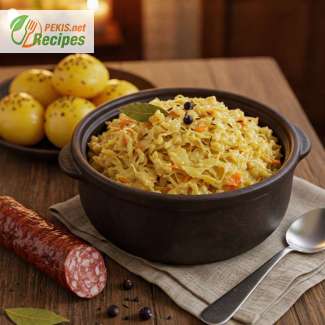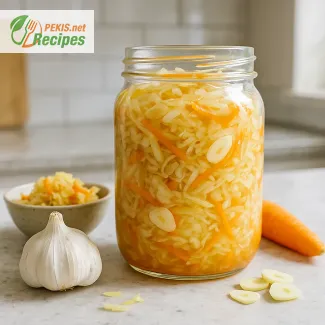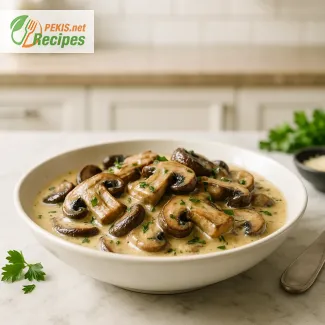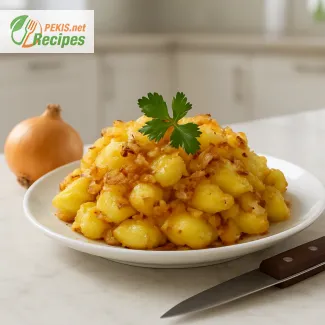Serves 4 people, with 15 minutes prep, 60 minutes cook, and a 75-minute total. Braised sauerkraut blends tangy fermented cabbage with onion, garlic, bacon, and warm spices like bay leaves and caraway for a deeply savory, tender side dish. Slow cooking transforms the texture into a melt-in-the-mouth comfort food that pairs perfectly with roasted meats or potatoes. Stores well: 2 days at room temperature, up to 5 days refrigerated, or 2 months frozen, and reheats in just 10 minutes. The result is a rustic, homely dish with rich layers of flavor, tradition, and versatility.
PEKIS – a professional chef and recipe developer with more than 25 years of experience, specialized in European and international cuisine. Over the years I’ve cooked countless versions of braised sauerkraut, from rustic tavern-style dishes to refined plates served at festive dinners. My work with fermented cabbage, smoky bacon, and warming spices has shown me how small details – like the right balance of acidity and sweetness – turn this humble side into something unforgettable.

Traditional flavors of braised sauerkraut for your table
A rustic dish with heritage and comforting depth
Braised sauerkraut carries with it a sense of warmth and tradition that has stood the test of time across Central and Eastern Europe. Slow cooking turns fermented cabbage into a silky, tender side dish with layers of flavor that range from mildly tangy to deeply savory. The gentle balance of sourness, sweetness, and umami makes it a versatile companion to roasted meats, sausages, or hearty potato dishes. Its simplicity is deceptive: behind every spoonful lies a craft perfected over generations.
Origins and culinary background
The roots of braised sauerkraut stretch back centuries, with strong associations in German, Czech, Polish, and Austrian kitchens. In rural communities, sauerkraut was a vital source of preserved vegetables during long winters. Once braised, its robust taste softened, creating a dish that was both nourishing and comforting. Over time, it moved from farm tables to festive occasions, becoming a beloved comfort food across Europe. Today, it remains equally at home in rustic taverns and modern kitchens, symbolizing both history and adaptability.
Why you will love this recipe
- Balanced flavors: the perfect mix of tangy, savory, and slightly sweet.
- Comforting texture: tender, melt-in-your-mouth cabbage.
- Versatility: pairs well with sausages, pork, poultry, and potato sides.
- Seasonal appeal: ideal for autumn and winter gatherings.
- Easy preparation: minimal effort, big rewards.
Key culinary elements
The success of braised sauerkraut lies in the interplay of simple ingredients. Cabbage fermented to the right degree offers brightness and acidity. Onions and garlic add sweetness and depth. Spices such as bay leaves, caraway seeds, and juniper berries infuse earthy and aromatic tones. Some regional versions include bacon or smoked meats for richness, while others lean towards vegetarian simplicity. The cooking fat—whether butter, lard, or vegetable oil—anchors the flavors and gives the dish a satisfying mouthfeel.
Creative variations to explore
- Add crisped bacon or smoked sausage for a heartier twist.
- Use apples or pears to highlight a gentle fruit sweetness.
- Mix in white wine or beer during braising for depth and aroma.
- Finish with a touch of cream for a milder, rounded flavor.
- Combine with potatoes for a one-pot rustic side.
Storing and preparing ahead
Braised sauerkraut is a dish that improves with time as flavors continue to meld.
- At room temperature: up to 2 days in a sealed container.
- Refrigerated: keeps well for 4–5 days.
- Freezing: up to 2 months without significant loss of flavor.
- Reheating: warm gently in the oven at 150 °C (300 °F) for 8–10 minutes or on the stovetop over low heat.
Semantically rich perspective on sauerkraut and braising traditions
Braised sauerkraut embodies the culinary principle of slow transformation—turning preserved cabbage into a soft, flavorful companion dish. The fermentation provides probiotics and a distinct tang, while braising develops a deep, caramelized sweetness. Across German “Geschmorter Sauerkraut,” Polish “Kapusta duszona,” and Czech “Dušené kysané zelí,” the dish shares a common thread: food that bridges nourishment with cultural identity. This dual role of sustenance and celebration is what has made it a timeless European staple.
Practical serving insights
- Works as a centerpiece side dish for roasted pork or duck.
- Complements potato dumplings, mashed potatoes, or spaetzle.
- Can be portioned individually or served in a large communal dish.
- Equally fitting for festive holiday meals or weeknight family dinners.
Ustvarjalne različice za sodobno kuhinjo
- Make it lighter by braising with vegetable broth and olive oil.
- Create a festive version with dried cranberries or chestnuts.
- Add a spicy kick with chili flakes for a modern fusion touch.
- Serve cold as part of a rustic salad with rye bread and smoked fish.
Braised sauerkraut continues to thrive because it adapts without losing its essence. Its foundation is humble, but its variations are limitless, making it a dish that speaks to both tradition and creativity.
- Heat vegetable oil in a large pot over medium heat. Add diced bacon and cook until crisp.
- Stir in chopped onion and sauté until golden. Add minced garlic and cook briefly.
- Add sauerkraut, stirring gently to coat with the flavors.
- Incorporate grated apple, caraway seeds, juniper berries, bay leaves, sugar, salt, and black pepper. Mix well.
- Pour in water or broth, bring to a gentle simmer.
- Reduce heat to low, cover the pot, and braise for about 45–50 minutes, stirring occasionally.
- Adjust seasoning before serving. Remove bay leaves and juniper berries.
FAQ questionWhat meats pair best with braised sauerkraut?
It goes perfectly with pork, sausages, duck, and roasted poultry, but it also works well alongside hearty potato dishes.
FAQ questionCan I make braised sauerkraut vegetarian?
Yes, simply skip the bacon and replace it with mushrooms or smoked tofu for depth and a savory kick.
FAQ questionHow long does braised sauerkraut keep?
At room temperature it lasts about 2 days, refrigerated 4–5 days, and frozen up to 2 months.
FAQ questionCan I reheat braised sauerkraut?
Absolutely. Warm it gently in the oven at 150 °C (300 °F) for 8–10 minutes or on the stovetop over low heat.
FAQ questionWhat ingredients can I add for variation?
Try apples, pears, or a splash of white wine or beer for extra flavor, or add cranberries and chestnuts for a festive twist.
FAQ questionIs braised sauerkraut only for winter?
It’s most popular in autumn and winter, but its bright and tangy flavor makes it a tasty side year-round.
The depth of braised sauerkraut lies in its ability to bring together fermented cabbage, gentle spices, and a touch of sweetness into one balanced dish. Its texture becomes soft and comforting, while the flavors grow richer with every bite. Whether paired with roast meats, sausages, or simple potato sides, it creates a table centerpiece that feels both rustic and refined.
Beyond tradition, this dish adapts easily to modern tastes. By adding apples, white wine, or even a vegetarian twist, the result can be tailored to any occasion. Easy to prepare, simple to store, and rewarding to reheat, it stands out as a side that never loses its charm. The harmony of flavor, texture, and history makes it a dish worth returning to time and again.
Allergens present in the recipe
- Bacon (pork protein, may cause intolerance in some individuals)
- Potential traces of gluten if broth is not gluten-free
Suggestions for allergen and gluten replacement
- Replace bacon with smoked tofu or mushrooms for a vegetarian and allergen-free option.
- Use certified gluten-free broth to avoid gluten traces.
- Substitute vegetable oil with olive oil for a lighter version.
- Vitamin C 18 mg – supports immune system and collagen formation
- Vitamin K 16 µg – contributes to blood clotting and bone strength
- Vitamin B6 0.2 mg – supports energy metabolism and brain function
- Potassium 280 mg – helps maintain fluid balance and muscle health
- Calcium 40 mg – important for bones and teeth
- Iron 1 mg – supports oxygen transport in the blood
- Magnesium 20 mg – essential for muscle and nerve function
- Polyphenols 120 mg – protect against oxidative stress
- Flavonoids 35 mg – support cardiovascular health
- Carotenoids 0.8 mg – contribute to eye and skin protection





